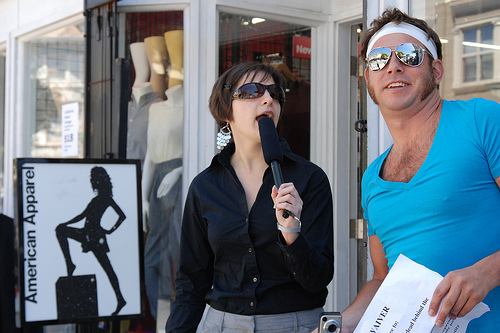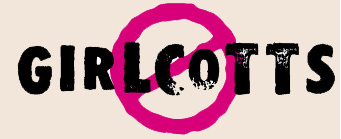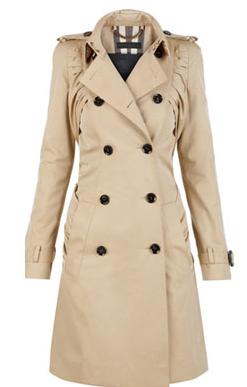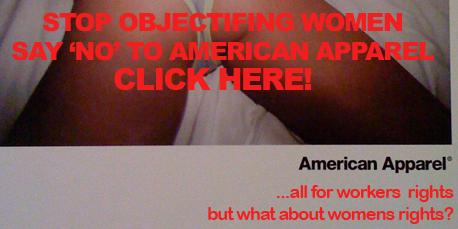 October 18, 2010 Ancient Chinese proverb: “The best soldiers are not warlike.”
October 18, 2010 Ancient Chinese proverb: “The best soldiers are not warlike.”
Welcome to youth activism 21st century style. (pithy “model waiver” for American Apparel street theater protest at left)
Huge on the fun factor, wry wit and massive outreach potential, (deploying via social media in nanoseconds) today’s youth are organizing via flash mob, street theater, viral video and POSITIVE guerrilla tactics that take aim at sexualization via covert AND overt actions in fresh new ways.
Whether targeting “repeat offenders” like American Apparel’s Dov Charney for sexploitation of teens (see Shaping Youth’s post: “Bottom Feeders That Need Whacked in the Assets”) or creating “user generated” dressing room decals to put “the beauty myth” in the cross-hairs, the notion of pushback against profiteering at the expense of girls’ sense of self is catching hold.
Today we’ll take to the trenches to learn from About-Face.org youth activist Melissa Campbell on the SPARK Summit blog tour.
Melissa gives us the scoop on the subversive tactics that work when giving a rebel yell, as she says, “…Sometimes it’s a two-pronged attack when looked at together: one to soothe the wounds of war, and one to take down the enemy army.” Love it.
Clearly, THIS generation of youth activism isn’t necessarily the ‘angry protester toting a sign’ variety…
…It’s online, offline, in your face, or under the radar with toolkits and deployment that’s scalable for global outreach in a finger snap.
Ammo of choice could be humor. Positivity. Parades. Concerts. Media spoofs. Even public health policy…as girls and young women tire of the unethical exploits of repeatedly selling soul erosion and insecurity for profit. (see APA research on harm)
Find out more as Melissa Campbell shares tips from this spring’s “We’re fed up with American Apparel” street theater spoof of uber-sexist harassment specialist retail CEO Dov Charney, known for his misogynistic corporate crud that’s layered deep within the American Apparel brand (both inside and outside the organization).
Today on the SPARK Summit blog tour, we’ll see how the face of youth activism is changing with social media, as leaders like Melissa take to the streets to chip away at soul eroding media messages and give us tips and take-aways to rally your own ‘battle cry’ whatever your methodology might be…
Take it away Melissa! Proud to host your amazing work!
Re-Imagining Youth Activism
Shaping Youth Interviews Melissa Campbell
About-Face.org Street Theater Actionistas Dress Down American Apparel’s Sexist Slop
This post is part of the SPARK blog tour…
You can follow the SPARK blog tour here, and look for tomorrow’s post at Scarleteen!
Amy Jussel, Shaping Youth: Melissa, As a 21-year old activist, how would you approach teens who ‘don’t see a problem” with sexualization and “don’t get what the big deal is?” (desensitization/urban wallpaper, social norming whatever)
What are best practices to get teens to consider your point of view on sexploitation, objectification & commodification? Persuasion theory? Counter-marketing? Evidentiary data of harm?
Melissa Campbell SPARK activist/youth team: I have a couple of different approaches. Most teenage girls have had the experience of getting unwanted sexual attention, either from peers or older people (getting catcalled on the street, etc) and because that’s a common experience, I generally use it to show how much culture objectifies women to the point where we expect to be catcalled or harassed just for daring to walk down the street or hallway.
A lot of teenagers haven’t made that connection at that point—I hadn’t, when I was in high school—but it’s a simple one that illuminates a lot of other problems and can lead to more nuanced discussions about the way women are affected by media.
I don’t generally drop statistics because it feels really impersonal, and I think the way to encourage girls to become dedicated to change is to make them understand how sexualization affects them personally before they engage with it on a larger level.
Amy Jussel, Shaping Youth: How much does location/regional environment & tonality of a protest (fun vs serious) enter into recruitment and success of activism?
Is there a difference between you leading the street theater production against American Apparel outside their SF retail store versus how you might adjust your messaging for heartland retail environs? Or is it scalable homogeneously in our ‘always on’ media culture?

Melissa Campbell SPARK activist/youth team: Location and tone are SO important when it comes to successful activism. The social and political climate of the area where the protest takes place is a huge factor in deciding how to approach a particular issue or piece of activism.
Staging fairly ironic street theater is going to be much more successful as far as garnering media coverage and law enforcement participation in more progressive places. When we designed the San Francisco street theater the goal was to engage San Francisco and San Fransicans on a level that they could not only understand, but get excited about.
I know for a fact that if we’d tried to do this action in a more suburban retail environment, like a mall, it would get shut down before we could even begin. (As it was, the police came about 40 minutes into our staging at Haight Street—everyone knows that once they call the cops, you’ve won!)
That doesn’t mean that someone wanting to stage an action in a more mall-like environment can’t do something fun, though. In fact, I’d say that fun is clutch no matter where you are.
When I say “fun,” I don’t necessarily mean silly like the AA action was. American Apparel is a company that, depending on how you look at it, either takes itself way too seriously or doesn’t take itself seriously at all, so lampooning them in a silly sort of way works…It depends on who you’re targeting….It’s important to pick up on the tone of the company (or organization or anything that you’re fighting back against) and use that tone against them in an interesting way.
Amy Jussel, Shaping Youth: So is fun a necessity for recruitment? Can you share some best practices as to what tips teens from “this is gross” or “ugh, this is absurd” to actually DOING something about their outrage?
Is ‘personal liability’ a deterrent for scaling actions? e.g. teens not wanting to ‘get in trouble?’—or is that a ‘value-add’ (rebel with a cause!?)
Melissa Campbell SPARK activist/youth team: “Fun” comes in with interactivity and ability to accommodate people of all levels of interest, making protest an open sort of atmosphere where people can move in and out and engage in their own way to their own ability. I was highly influenced by Stephen Duncombe’s Dream: Reimagining Progressive Politics in an Age of Fantasy and recommend it for creating effective change…
 For me, staging street theater is fun because I like being over the top and absurd, but for someone very shy street theater would be torturous! It’s all about access, because the more accessible your action is, the louder you can speak out against the thing that ails you.
For me, staging street theater is fun because I like being over the top and absurd, but for someone very shy street theater would be torturous! It’s all about access, because the more accessible your action is, the louder you can speak out against the thing that ails you.
The message can be the same across the board, but the way the message is delivered definitely depends on location and tone. Some people don’t want to be yelling and holding signs and chanting, it’s much more productive to find ways for them to participate on their own terms rather than trying to convince people that one particular brand of activism is best.
The way we approached that with the AA protest was by creating jobs and duties on all levels, from distributing fliers both before & during the protest, helping draft petition letters, and acting as audience members.
That’s a really important thing in street theater and improv/flashmobs actually… planning a built-in audience, because when people see other people watching something, they’ll stop and watch.
 So to be an activist in our action, you could literally just stand there and watch, or maybe take a walk around the block and talk kind of loudly about “omg, did you see what’s going on in front of American Apparel?”
So to be an activist in our action, you could literally just stand there and watch, or maybe take a walk around the block and talk kind of loudly about “omg, did you see what’s going on in front of American Apparel?”
That way, for teens who “don’t want to get in trouble” they can be almost totally hands-off. As I said, the cops broke up our protest, and when they did we left. We didn’t have a permit (it would have been nearly impossible to get one since AA would have had to sign off on liability for us to be in front of the store) and it wasn’t an issue we were willing to push, so we moved on.
From my end, cooperation with police is really important, and knowing your local laws (and keeping to them!) is key. And btw, recruitment IS hard. Straight up difficult, sometimes impossible.
We recruited through word of mouth, fliers, email list-servs and CraigsList ads, and still had only a very small group of core activists, maybe 5 or 6 all told. Part of it was because of a necessary change of date that made people unavailable, but when thinking about recruitment, especially for street-theater type things, it’s important to remember that you’ll be able to gain “participants” the day of—spectators are participants!
People who are shopping and stop to watch even for 30 seconds are participants. If you can get a flier into someone’s hand, that person is a participant!
Amy Jussel, Shaping Youth: Have you ever been accused of being “confrontational” or being a “bully” (either by the shoppers or by the corporations you target) And if so, how do you handle that pushback?
Melissa Campbell SPARK activist/youth team: I’ve been told to shut up, that I’m overreacting, that I’m too sensitive or—my favorite—that I “just need to get laid,” as if my objecting to female sexuality being exploited for sales purposes means that I’m objecting to my own sexuality.
I used to dedicate a lot of time trying to educate people who started these “debates” with me, but the honest truth is, a lot of them aren’t interested in learning, they just want to be jerks or they feel threatened or something, I’m not sure what.
I think the rhetoric surrounding these objections is really important: girls are trained from birth to be delicate, quiet, polite, in the background, etc. We’re “not supposed” to be loud or pushy or have opinions so when we do—especially when they’re opinions about wanting to take control of our own bodies and sexualities—we’re seen as being confrontational or bullies.
Of COURSE I’m being confrontational right now, because I’m affected by this every single day and it hurts me and people I love, and I have every right to get mad about that and how dare you suggest otherwise? But we get labeled bitchy or loud or shrewish in an attempt to de-legitimize our completely legitimate and important concerns. (Visual above is part of the ‘best bottoms’ AA pornification protest via the AnyBody site)
Amy Jussel, Shaping Youth: When did you first get involved with About-Face and were you involved with the positive positioning of ‘dressing room’ guerrilla tactics to debunk beauty myths?
How did that campaign differ from the American Apparel activism? Which do you deem ‘most successful?’ (e.g. easier to recruit/participate in) or which did you simply like better?
 Melissa Campbell SPARK activist/youth team: I started working with About-Face in January 2010, so unfortunately I missed the first wave of the dressing room action. But I was involved in its resurrection (I was cutting out decals for what felt like days!) and I love love love love love the action as a whole. It was actually one of the About-Face.org actions that made me want to work with them so badly!
Melissa Campbell SPARK activist/youth team: I started working with About-Face in January 2010, so unfortunately I missed the first wave of the dressing room action. But I was involved in its resurrection (I was cutting out decals for what felt like days!) and I love love love love love the action as a whole. It was actually one of the About-Face.org actions that made me want to work with them so badly!
I hate to think of one action as more successful than the other; I’m not sure there would even be a way to measure that. And, well, the American Apparel street theater was like my baby, so it’ll always have a special place in my heart. I even have the “Meet Dov Charney” promo flier hanging on my bedroom wall in Queens! But the campaigns were so, SO different.
The dressing room action is focused on positive change within yourself, empowering yourself to reject all the BS in the media and knowing that you’re beautiful no matter what those ads are suggesting, while the American Apparel action was way more about taking down those ads.
They’re a two-pronged attack when looked at together: one to soothe the wounds of war, and one to take down the enemy army.
Amy Jussel, Shaping Youth: Can you cite some measurements and outcomes as a result of ‘girlcotting’ tactics (either in reduced foot traffic/sales figures or PR cost/media coverage/reputation damage?)
At Shaping Youth, for example, we’ve made it a point to avoid the Zazzle/Cafe Press AA tees, even though it’s the easiest way to ‘do uniforms’ —and everytime we’re at a festival that uses AA for tees, we give them info as to why we won’t buy.
Melissa Campbell SPARK activist/youth team:
 There was the recent uproar about Urban Outfitter’s terrible “Eat Less” shirt.
There was the recent uproar about Urban Outfitter’s terrible “Eat Less” shirt.
…That got pulled from shelves thanks to savvy feminist activists speaking out against it. And while there’s no spoken connection between the criticisms of American Apparel’s advertising and hiring practices, they did almost just go under and I’d like to think at least part of that is more and more savvy consumers choosing to shop at places that don’t treat women like sex objects.
I know I’ve converted several people to the anti-AA brigade, and I have hopes that there’s even more of us out there slowly driving Dov Charney into bankruptcy one unpurchased deep V neck at a time!
Amy Jussel, Shaping Youth: What is the best delivery method to scale activism in your opinion? Social media deployment? Flash mobs? Guerrilla tactics? Toolkits? Tees? Training for activism?
Who would be your ‘dream team’ to add fiscal clout to efforts like this with About-Face?
Melissa Campbell SPARK activist/youth team: All of the above! I think social media as activism has so much amazing potential (I’m actually writing a thesis about this! “Moving through the Fatosphere: the Internet & Radical Body Politics”) not only to spread ideas but to provide spaces to develop new ones.
Toolkits are fantastic, too, because they make activism easier. Anything that makes activism easier for most people (even if it’s more time consuming for the organizers) is so important.
As far as dream collabs, oh man. I would say Geena Davis but now she’s speaking at SPARK so maybe that dream is on its way to coming true! Kate Winslet, too, has spoken beautifully about the way media sexualizes and changes women’s bodies, and having her on our side more vocally would be amazing.
But for the most part, I’m wary of celebrity endorsements and sponsorships because I feel like the most important change needs to come from the girls who are most affected by these things. Grassroots, you know? It’s so inspiring.
Amy Jussel, Shaping Youth: How can teens across the country (globe!) take action when they see uber-sexualized campaigns marketed to the masses?
Will there be an activist ‘toolkit’ they can download and deploy to scale? Does this exist in full at About-Face or is this a SPARK Summit suggestion? (see Teens Turning Green Toolkits on SY sidebar for scalable ‘how-tos’)
Melissa Campbell SPARK activist/youth team:
About-Face.org has awesome suggestions on their website, plus activist kits and ways to get in touch with companies that need good talking-to. But honestly, the best way to do it is to just DO IT! Find a way to express what you’re feeling in whatever way works for you—distribute a zine, write street theater, keep a blog, picket a store, circulate a petition, but most of all RAISE A FUSS! Call attention! Make it totally your own style.
Amy Jussel, Shaping Youth: What are your goals/hopes for the SPARK Summit in terms of igniting teen passions around this issue?
How can we engage inactive but peeved participants to join in and play a pivotal role?
Melissa Campbell SPARK activist/youth team:
I want girls to get mad about the way their bodies and sexualities are being co-opted and I want them to know that it’s OK for them to be mad—that it’s GOOD for them to be mad! I want to help build a generation of young women who aren’t scared to speak up and speak out and claim their bodies as their own.
 Engaging the shy or inactive is tricky but honestly, by even vocally aligning yourself with a radical stance against sexualization, you’re helping. Even just saying “this makes me mad and here’s why” is helping.
Engaging the shy or inactive is tricky but honestly, by even vocally aligning yourself with a radical stance against sexualization, you’re helping. Even just saying “this makes me mad and here’s why” is helping.
Telling even one person “I don’t shop at this store because their advertising is sexist and disgusting”—and then sticking to that statement and not shopping there—is helping! Everything helps and every role is pivotal in a culture that is constantly pushing women back.
As for SPARK…I could talk for hours and days about how excited I am to be part of it and how much I want to see come out of this…
Amy Jussel, Shaping Youth: Sounds like you’re moving far beyond ‘spark’ and heated with positive energy on the topic…ready to ‘burn down the house’ with that enthusiasm.
Can’t wait to meet you next week, Melissa. You inspire!
Flame on!
 More About SPARK: (And stay tuned all this week on Shaping Youth for coverage of sexualization topics)
More About SPARK: (And stay tuned all this week on Shaping Youth for coverage of sexualization topics)
SPARK stands for Sexualization Protest: Action, Resistance, Knowledge.
SPARK is both a Summit and a Movement designed to push back against the increasingly sexualized images of girlhood in the media and create room for whole girls and healthy sexuality.
SPARK will engage teen girls to be part of the solution rather than to protect them from the problem.
The SPARK Summit will launch a grassroots movement to support and stand with girls. Scheduled for this Friday, October 22nd at Hunter College in New York City, the Summit is a day to speak out, push back on the sexualization of girls, and have fun while igniting a movement for girls’ rights to healthy sexuality.
The Summit will give girls between the ages of 14-22 the information and tools they need to become activists, organizers, researchers, policy influencers, and media makers.
The Summit is focused on working with girl leaders and activists to jump start an intergenerational movement among 14-22 year old girls and those working closely with them. There will also be a Virtual Summit so that girls and adults who cannot make it to New York City can participate.
In just 5 days there will be:
Ø Girls and women from across the country coming together, in-person and online, to challenge the sexualization of girls and begin a new social movement;
Ø Workshops, action stations, and presentations led by inspiring and prominent leaders in the fields of activism, research, policy, and advocacy;
Ø A Halloween costume fashion show with designs by girls that showcase alternatives to the over-exposed costumes typically available to them;
Ø AND, actress and activist Geena Davis, MTV personality Amber Madison, and media critic Jean Kilbourne engaging in and supporting the SPARK Summit, Day One of the SPARK Movement!
Here’s the brand new SPARK widget to share, post, tweet, and forward to a friend…spread the word to ignite change and spark this bonfire, baby!










thanks for sharing Amy. I will sit on on the session remotely on Friday.